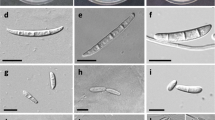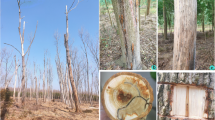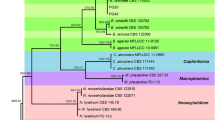Abstract
This study aimed to determine the genetic variability of isolates of rotting of pineapple fruitlet core in Brazil on the states of Paraiba, Pernambuco and Rio Grande do Norte, based on phylogenetic analysis of the RPB2 gene, morphocultural markers and aggressiveness of the isolates. The phylogenetic reconstruction of maximum parsimony and bayesian inference of the isolates were performed. Twenty-seven phylogenetic lineages were characterized with morphocultural markers on potato dextrose agar and synthetic nutrient-poor agar. The aggressiveness of these lineages were characterized in leaves and fruits of pineapple ‘Pérola’ cultivar. The Phylogenetic reconstruction showed close relationship between isolates of this study and phylogenetic lineages of F. guttiforme, F. ananatum and F. oxysporum by analysis of RPB2 gene. Phylogenetic lineages of this study shared significant morphocultural markers similar to those described for this species. Overall, the lineages related with Fusarium oxysporum Species Complex were more aggressive to the fruits of the Fusarium lineages related with Fusarium fujikuroi Species Complex. It is possible that F. ananatum and F. guttiforme or other lineages closely related to these species or F. oxysporum are present in the fields causing pineapple rotting fruitlet core in fruits of pineapple ‘Pérola’ in Brazil. The used markers determined high genetic variability in isolates analyzed in leaves and pineapple fruit ‘Pérola’ in the states of Paraíba, Pernambuco and Rio Grande do Norte of Brazil and the pathogenic lineages analyzed were better adapted to the fruits than to the detached leaves in pineapple ‘Pérola’ analyzed.






Similar content being viewed by others
References
Al-Hatmi, A. M. S., Mirabolfathy, M., Hagen, F., Normand, A.-C., Stielow, J. B., et al. (2015). DNA barcoding, MALDI-TOF and AFLP data support Fusarium ficicrescens as a distinct species within the F. fujikuroi species complex. Fungal Biology, 120, 265–278. https://doi.org/10.1016/j.funbio.2015.08.001.
Ali, M. A., Devi, L. I., Lyngdoh, W. M., Das, G., Prasad, H., et al.(2011). Comparative biochemical profile of Ascaridiagalli infected broiler chickens on administration of pineapple and Neem leaves and piperazine. International Journal of Poultry Science, 10(7), 542–546.
Aoki, T., O’Donnell, K., & Geiser, D. M. (2014). Systematics of key phytopathogenic Fusarium species: Current status and future challenges. Journal of General Plant Pathology, 80, 189–201.
Aquije, G. M. F. V., Zorzal, P. B., Buss, D. S., Ventura, J. A., Fernandes, P. M. B., & Fernandes, A. A. R. (2010). Cell wall alterations in the leaves of fusariosis-resistant and susceptible pineapple cultivars. Plant Cell Reports, 29, 1109–1117.
Azevedo, J.L. (2009) Genética de microrganismos. 2 (1), Goiania: Editora UFG.
Bonfield, J. K., & Whitwham, E. (2010). A.Gap5—Editing the billion fragment sequence assembly. Bioinformatics, 26, 1699–1703.
Bueno, C. J., Ambrósio, M. M. Q., & Souza, N. L. (2007). Production and evaluation of survival of resistance structures of soilborne phytopathogenic fungi. Summa Phytopathologica, 33(1), 47–55.
Crespo, F. M., Carzola, A., De Vicente, E., Arrebola, J. A., Torés, M., Maymon, S., Freeman, T., Aoki, T., & O’Donnell, K. (2016). Analysis of genetic diversity of Fusarium tupiense, the main causal agent of mango malformation disease in southern Spain. Plant Disease, 100(2), 276–288.
Garcia, W. A., Krause, W., Araújo, D. V., Silva, C. A., & Miranda, A. F. (2015). Behavior in vitro of the Fusarium guttiform and evaluation of the inoculation methods in the laves of pineapple. Revista Caatinga, 28(3), 263–268.
Geiser, D. M., Jimenez Gasco, M. M., Kang, S., Mkalowska, I., Veeraghavan, N., Ward, T. J., Zhand, N., Kuldal, G. A., & O’Donnell, K. (2004). FUSARIUM-IDv.0: A DNA sequence databases for identifying Fusarium. European Journal of Plant Pathology, 110, 473–479.
Gu, H., Zahan, R. L., Zhang, L. B., Gong, D. Q., & Jia, J. W. (2015). First report of Fusarium ananatum causing Pinneapple fruitlet Core rot in China. Plant Disease, 99(11), 1653–1653.
Instituto Brasileiro de Geografia e Estatística. (2016). Levantamento sistemático da produção agrícola. ftp://ftp.ibge.gov.br/Producao_Agricola/Fasciculo_Indicadores_IBGE/estProdAgr_201609.pdf. Accessed 18 November 2016.
Jacobs, A., Van Wyk, P. S., Marasa, W. F., Wingfield, B. D., Wingfield, M. J., & Coutinho, T. A. (2010). Fusarium ananatum sp. nov. in the Gibberella fujikuroi species complex from pineapples with fruit rot in South Africa. Fungal Biology, 114(7), 515–527.
Kvas, M., Marasas, W. F. O., Wingfield, B. D., Wingfield, M. J., & Steenkamp, E. T. (2009). Diversity and evolution of Fusarium species in the Gibberella fujikuroi complex. Fungal Diversity, 34, 1–21.
Laurence, M. H., Summerell, B. A., & Burgess, E. C. L. (2014). Genealogical concordance phylogenetic species recognition in the Fusarium oxysporum species complex. Fungal Biology, 118(4), 374–384.
Leslie, J. F., & Summerell, B. A. (2006). The fusarium laboratory manual. Ames, IA, USA: Blackwell Pub.
Leslie, J. F., Anderson, L. L., Bowden, R. L., & Lee, Y. W. (2007). Inter- and intra-specific genetic variation in Fusarium. Int. J. Food Mircobiol, 119, 25–32.
Librado, P., & Rozas, J. (2009). DnaSPv5: A software for comprehensive analysis of DNA polymorphism data. Bioinformatics, 25, 451–1452.
Lima, C. S., Pfenning, L. H., Costa, S. S., Abreu, L. M., & Leslie J.F. (2012). Fusarium tupiense sp. nov., a member of the Gibberella fujikuroi complex that causes mango malformation in Brazil. Mycologia, 104, 1408–1419.
Moussa, T. A. A., Al-Zahrani, H. S., Kadasa, N. M. S., Ahmed, S. A., Hoog, G. S., & Al-Hatmi, A. M. S. (2017). Two new species of the Fusarium fujikuroi species complex isolated from the natural environment. Antonie Van Leeuwenhoek. https://doi.org/10.1007/s10482-017-0855-1.
Nelson, P. E., Toussoun, T. A., & Marasas, W. F. (1983). O. Fusarium species: An illustrated manual for identification. Pennsylvania: Penn state university press.
Nelson, P. E., Toussount, T. A., & Burgess, L. W. (1987). Characterization of Fusarium-beomiforme Sp - Nov. Mycologia, 79, 884–889.
Nirenberg, H. I., & O'Donnell, K. (1998). New Fusarium species and combinations within the Gibberella fujikuroi species complex. Mycologia, 90(3), 434–458.
Nogueira, S. R., Lima, F. S., Rocha, E. M., & Araújo, D. H. (2014). Fungicides in fusariosis pineaple control in the state of Tocantins, Brazil. Revista de Ciências Agrárias, 37(4), 447–455.
O'Donnell, K., Sutton, D. A., Rinaldi, M. G., Sarver, B. A., Balajee, S. A., Schroers, H. J., & Aoki, T. (2010). Internet-accessible DNA sequence database for identifying fusaria from human and animal infections. Journal of Clinical Microbiology, 48(10), 3708–3718.
O'Donnell, K., Rooney, A. P., Proctor, R. H., Brown, D. W., Mccormick, S. P., Ward, T. J., & Robert, V. A. (2013). Phylogenetic analyses of RPB1 and RPB2 support a middle cretaceous origin for a clade comprising all agriculturally and medically important fusaria. Fungal Genetics and Biology, 52, 20–31.
O'Donnell, K., Sarver, B. A., Brandt, M., Chang, D. C., Noble-Wang, J., Park, B. J., & Geiser, D. M. (2007). Phylogenetic diversity and microsphere array-based genotyping of human pathogenic fusaria, including isolates from the multistate contact lens-associated US keratitis outbreaks of 2005 and 2006. Journal of Clinical Microbiology, 45(7), 2235–2248.
Ploetz, R.C. (2001). Significant diseases in the tropics that are caused by species of fusarium. In M. J. Jeger (Ed.), Fusarium: Paul E. Nelson memorial symposium, (pp. 295–309). The American Phytopathological society press: St. Paul, MN.
Ploetz, R. C. (2006). Fusarium- induced diseases of tropical, perennial crops. Phytopathology, 96(6), 648–652.
Ploetz, R. C. (2007). Diseases of tropical perennial crops, challenging problems in diverse environments. Plant Disease, 91(6), 644–663.
Py, C., Lacoevilhe, J. J., & Teisson, C. (1984). L’ Ananas: Sa cultura, ses produits. Paris: Maisonneuve & Larose.
Rohrbach, K.G., & Schmitt, D. (2003). Diseases of pineapple. In Ploetz, R. C (Ed.), Diseases of tropical fruit crops, (pp. 443–465). CABI Publishing: Wallingford.
Souza, B. O., Souza, E. A., & Mendes-Costa, M. C. (2007). Determination of variability in isolates of Colletotrichum lindemuthianum based on morphological and cultural markers. Ciência e Agrotecnologia, 31(4), 1000–1006.
Souza, B. O., Casela, C. R., Nunes, J. A., & Castro, H. A. (2013). Management of sorghum anthracnose through diversification of genetic resistance in host population. Tropical Plant Pathology, 38(1), 020–027.
Stepień, L., Koczyk, G., & Waśkiewicz, A. (2013). Diversity of Fusarium species and mycotoxins contaminating pineapple. Journal Applied Genetics, 54(3), 367–380.
Triest, D., Stubbe, D., De Cremer, K., Piérard, D., Detandt, M., & Hendrickx, M. (2015). Banana infecting fungus, Fusarium musae, is also an opportunistic human pathogen: Are bananas potential carriers and source of fusariosis? Mycologia, 107(1), 46–53.
Ventura, J. A., Zambolim, L., & Chaves, G. M. (1993). Integrated management system for pineapple fusarium disease control. Acta Horticulturae, 334, 439–453.
Verzignassi, J. R., Santos, M. D. F., Matos, A. P. D., Benchimol, R. L., & Poltronieri, L. S. (2009). Fusariose do abacaxizeiro no Pará. Summa Phytopathologica, 35(4), 329–330.
Acknowledgments
Wilza C O Souza received a PhD fellowship from National Counsel of Technological and Scientific Development (CNPq). Mônica Danielly de Mello Oliveira received a post-doctoral fellowship from CAPES-EMBRAPA. In memory of Breno O Souza for his immense help and work.
Author information
Authors and Affiliations
Corresponding author
Rights and permissions
About this article
Cite this article
Souza, W.C.O., Nascimento, L.C., Oliveira, M.D.M. et al. Genetic diversity of Fusarium spp. in pineapple ‘Pérola’ cultivar. Eur J Plant Pathol 150, 853–868 (2018). https://doi.org/10.1007/s10658-017-1328-0
Accepted:
Published:
Issue Date:
DOI: https://doi.org/10.1007/s10658-017-1328-0




